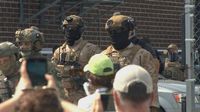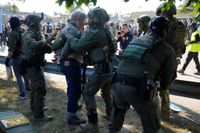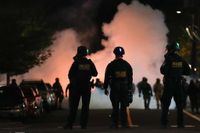On October 9, 2025, a sweeping federal court order sent shockwaves through Chicago and beyond, as U.S. District Judge Sara Ellis issued a temporary restraining order barring federal immigration agents from using tear gas, pepper spray, rubber bullets, and other so-called “riot control weapons” against peaceful protesters, journalists, and clergy—unless those individuals pose an immediate threat to physical safety. The order, which applies to all federal law enforcement personnel in the Northern District of Illinois, marks a pivotal moment in the ongoing tension between federal authorities and civil liberties advocates in the city.
The ruling comes in response to a lawsuit filed by a coalition of journalists, media organizations—including the Chicago Headline Club, Block Club Chicago, and the Chicago Newspaper Guild Local 34071—alongside religious leaders and community activists. Their suit alleges a sustained campaign of excessive force and intimidation by Immigration and Customs Enforcement (ICE) agents at the Broadview immigration processing facility, a flashpoint in President Donald Trump’s “Operation Midway Blitz” targeting immigration enforcement in Chicago. According to multiple reports cited in the lawsuit, federal agents have repeatedly deployed chemical agents and projectiles at crowds gathered outside the facility, affecting not only protesters but also first responders, local police, and members of the media.
The temporary restraining order, which took effect the morning of October 9 and is set to last for 14 days, prohibits federal officers from firing tear gas, pepper balls, or less lethal bullets at reporters, protesters, or clergy unless there is an immediate threat to the safety of law enforcement. Judge Ellis was explicit in her reasoning: “The actions taken by some of those federal agents clearly violated the Constitution,” she said from the bench, as reported by Chicago News Service. “Individuals are allowed to protest. They are allowed to speak. That is guaranteed by the First Amendment to our Constitution, and it is a bedrock right that upholds our democracy.”
The order further requires federal agents to stop dispersing people who have a lawful right to be at a location, and it mandates that Department of Homeland Security agents and other federal officials must give at least two audible warnings before deploying any riot control weapons. All federal agents must also bear visible identification on their uniforms or helmets, unless doing so would conflict with standard protocol or undercover duties.
While the order does not specifically apply to the National Guard, which has also been deployed to federal sites in the area, Judge Ellis cautioned against any attempt by the Guard to circumvent the spirit of her ruling. “I do not want the Guard to do a ‘work around’ of the order,” she stated, making clear her intent to prevent any loopholes.
The lawsuit that prompted the order is filled with harrowing accounts of violence and intimidation. One protester, Leigh Kunkel, testified in a court filing that she was peacefully demonstrating when she was shot with pepper balls in the back of her head and nose, leaving her face bloodied. She described how federal agents fired on protesters who were simply taking a break and drinking water, and recounted how her fiancé was thrown to the ground by officers, causing ongoing pain and difficulty breathing. Journalists reported being singled out for detention, shot by projectiles, and exposed to gas pellets. Even members of the clergy were not spared; a minister in clerical garb said he was shot at and gassed while praying in front of the Broadview facility.
According to Block Club Chicago, at least four of their employees or freelancers have reported being hit with pepper balls and subjected to tear gas by federal agents since September 19. In a particularly alarming incident, an ICE agent allegedly fired a pepper ball at a CBS Chicago reporter outside the facility when no protesters were present, prompting a criminal investigation by Broadview police.
Federal agents, for their part, painted a very different picture in their court filings. ICE Field Officer Director Russell Hott described protesters blocking access to the facility, vandalizing buildings and vehicles, and even jumping on the hoods of moving cars to slash tires. Hott detailed the toll on law enforcement: more than thirty officers injured in the clashes, suffering everything from torn ACLs and lacerations to bruises, hospitalizations, and a hyper-extended knee. He also recounted an incident in which an agent was followed home, confronted, and had his car broken into, resulting in a stolen weapon. ICE reported using over $100,000 worth of less lethal munitions and chemicals for crowd control in just two weeks in September, and said about fifty individuals had been arrested for assault, obstruction, trespassing, and other charges during the protests.
Attorneys for the Trump administration objected strenuously to the restraining order. Sean Skedzielewski, representing the Department of Justice, told the court the order “will be unworkable and will cause a lot of problems.” He argued that such restrictions would “dictate crowd-control policy” in ways that would “tie the hands” of federal law enforcement officers, potentially putting both officers and the public at greater risk. In a written brief, Skedzielewski insisted, “Such restrictions improperly limit law enforcement’s ability to engage in legal enforcement operations, while increasing the potential for injuries to CBP agents, members of the public interfering with law enforcement operations, or arrested subjects.”
Judge Ellis, however, was unmoved by these objections. She emphasized that her order “essentially directs agents and officers to follow the training that they’ve already received on use of force. [It’s] essentially directing them to follow their own rules, policies and regulations, the laws that apply to them and the behavior that the Constitution demands.” She declined to limit the order solely to the Broadview facility, explaining, “If I felt secure that this was only happening in Broadview, I’d be happy to limit it, but I don’t believe that is the case, and so I am not going to limit the TRO simply to Broadview.”
The Chicago Headline Club hailed the ruling as a landmark for press freedom. “The Chicago Headline Club stood up for the First Amendment, and the judge delivered a significant victory for press freedom,” the club’s board of directors said in a written statement. Jon Schleuss, president of The NewsGuild-CWA, echoed the sentiment, stating, “Journalism is not a crime. Every American must loudly condemn the Trump administration’s assault on our First Amendment rights.”
Not everyone is celebrating, however. DHS Assistant Secretary Tricia McLaughin urged caution, warning that “covering unlawful activities in the field does come with risks—though our officers take every reasonable precaution to mitigate those dangers to those exercising protected First Amendment rights.”
The legal battle is far from over. The parties are due back in court on October 23, when the 14-day window of the temporary restraining order expires, to discuss the future of these restrictions. Meanwhile, Illinois is pursuing a separate lawsuit to block the deployment of the National Guard to Chicago—another front in the ongoing conflict over federal intervention in the city’s affairs. On October 9, a different federal judge temporarily blocked President Trump’s deployment of approximately 500 National Guard members, further complicating the landscape.
For now, Judge Ellis’s order stands as a powerful affirmation of constitutional rights in the face of extraordinary federal pressure. Whether it will lead to lasting change remains to be seen, but for journalists, protesters, and clergy in Chicago, the ruling offers a measure of protection—and a glimmer of hope.


